No products in the cart.
Thomas Cole’s Voyage of Life
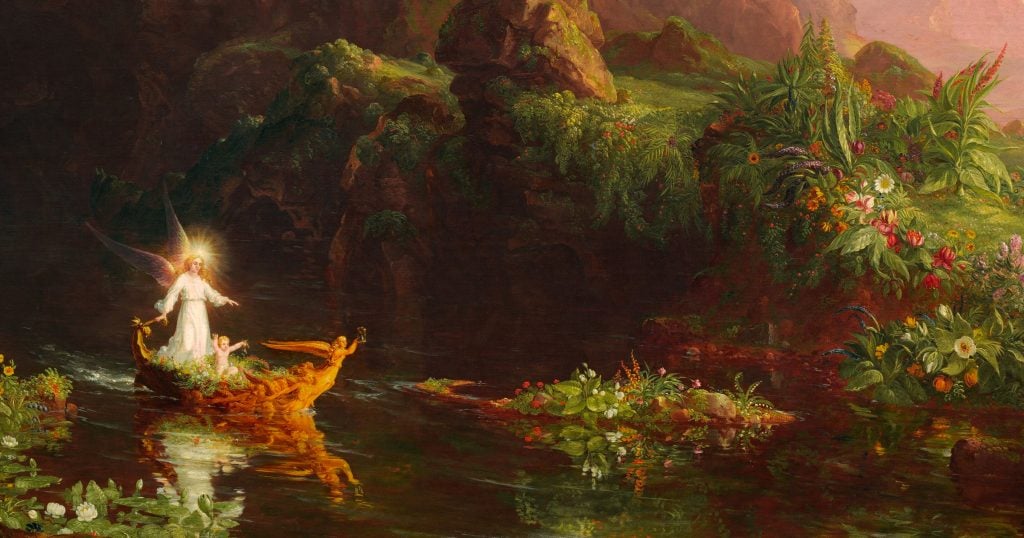
Thomas Cole elevated American landscape painting during the first half of the 19th century. His evocations of the Hudson River Valley juxtaposed the pastoral with the sublime, providing the inspiration for America’s first native art movement, the Hudson River School. He also tested the boundaries of what artistic statements were possible in the landscape genre.
Painters of his era observed a hierarchy of genres that had been formalized over centuries. At its pinnacle stood history painting, which included religious, mythological and allegorical subjects, followed by portraiture and scenes of everyday life. It was held that these figurative genres were more concerned with the expression of universal truths than landscape, animal painting and still life, which were mostly exercises in reproduction. Cole challenged this view.
“I am not a mere leaf painter,” he wrote in a journal entry for 1838. “I have loftier conceptions than any mere combinations of inanimate and uninformed nature.” He pursued a “higher style of landscape” that used allegory convey the same edifying messages as European history paintings, but without their vainglorious (he believed) emphasis on the human form. Instead, he used the mood and symbolism of the landscape to comment on the events unfolding therein. In paired and serial canvases, he constructed narratives wherein a set of motifs might develop subtly, or contrast sharply, from picture to picture.
The Voyage of Life is arguably Cole’s most sophisticated expression of this higher style. The four-part series depicts a symbolic hero’s pilgrimage through the four phases of life: Childhood, Youth, Manhood and Old Age, corresponding to innocence, hope, faith and salvation. It exists in two iterations: a commissioned set completed in 1840 and a second, slightly refined version (shown here), in 1842.
I. Childhood
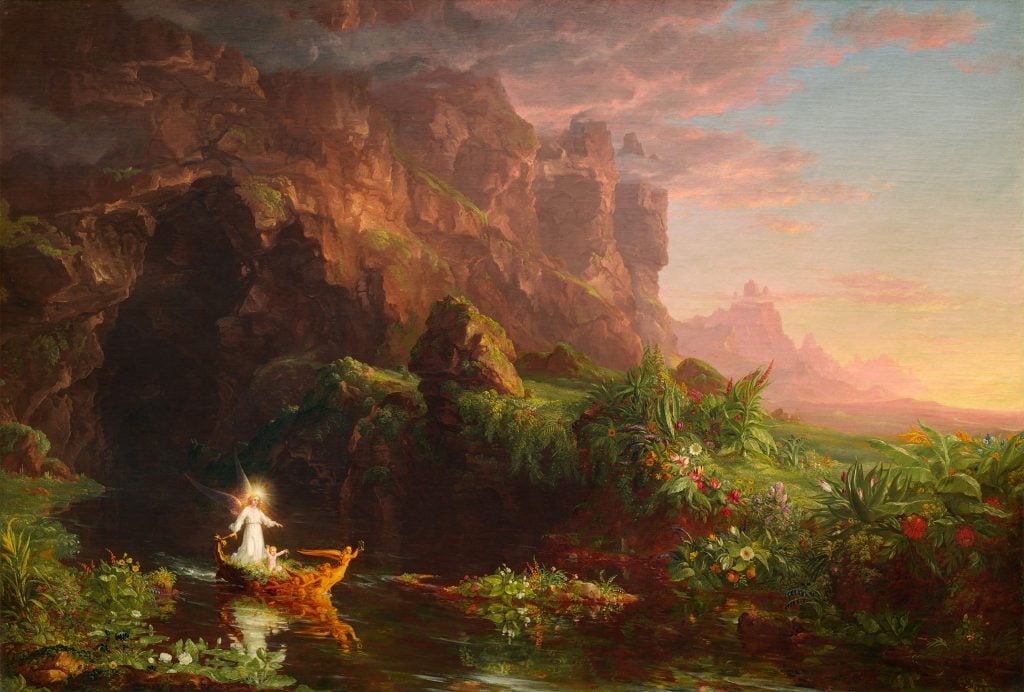
Order Print
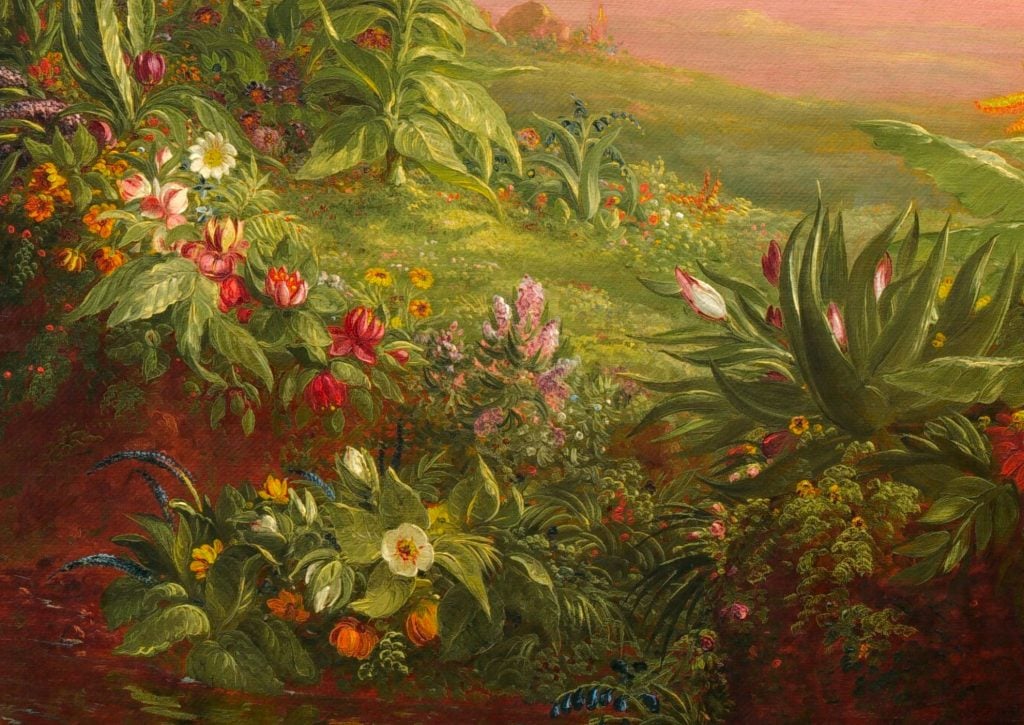
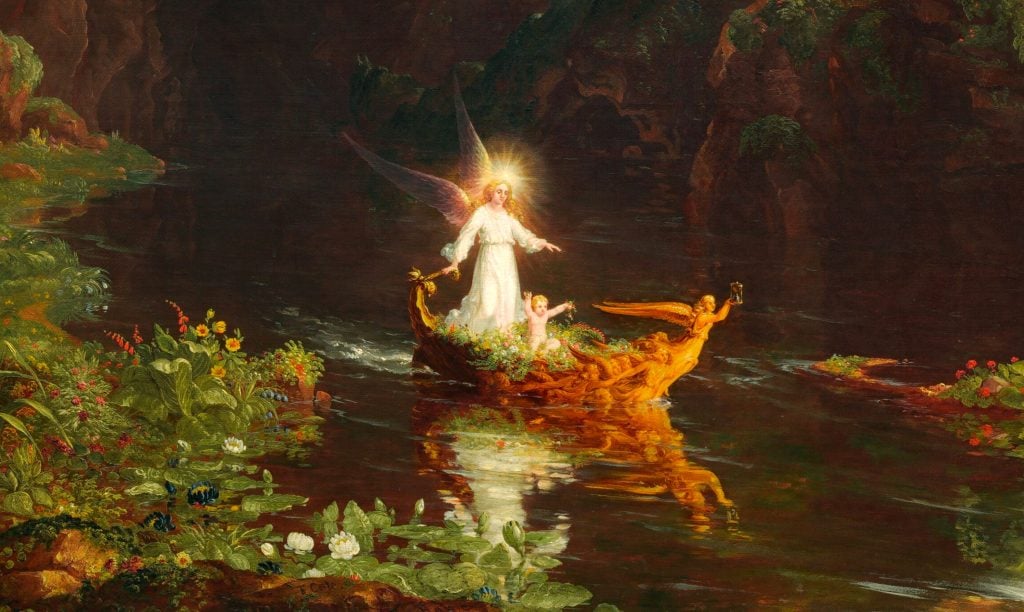
Childhood introduces the infant voyager, his guardian spirit and the golden vessel (symbolic of time) that bears on him on the Stream of Life. These are principal motifs that Cole will use to develop his narrative. When the series was first exhibited in New York, he provided a pamphlet with his own explanatory text. Of Childhood, he wrote:
“A stream is seen issuing from a deep cavern, in the side of a craggy and precipitous mountain, whose summit is hidden in clouds. From out the cave glides a Boat, whose golden prow and sides are sculptured into figures of the Hours: steered by an Angelic Form, and laden with buds and flowers, it bears a laughing Infant, the Voyager whose varied course the artist has attempted to delineate. On either hand the banks of the stream are clothed in luxuriant herbage and flowers. The rising sun bathes the mountains and the flowery banks in rosy light. “The dark cavern is emblematic of our earthly origin, and the mysterious Past. The Boat, composed of Figures of the Hours, images the thought, that we are borne on the hours down the Stream of Life. The Boat identifies the subject in each picture. The rosy light of the morning, the luxuriant flowers and plants, are emblems of the joyousness of early life. The close banks, and the limited scope of the scene, indicate the narrow experience of Childhood, and the nature of its pleasures and desires. The Egyptian Lotus in the foreground of the picture is symbolical of Human Life. Joyousness and wonder are the characteristic emotions of childhood.”
This Enlightenment ideal of childhood was still progressive for its time, the first campaigns for child labor reform having gained traction during the 1830s.
II. Youth
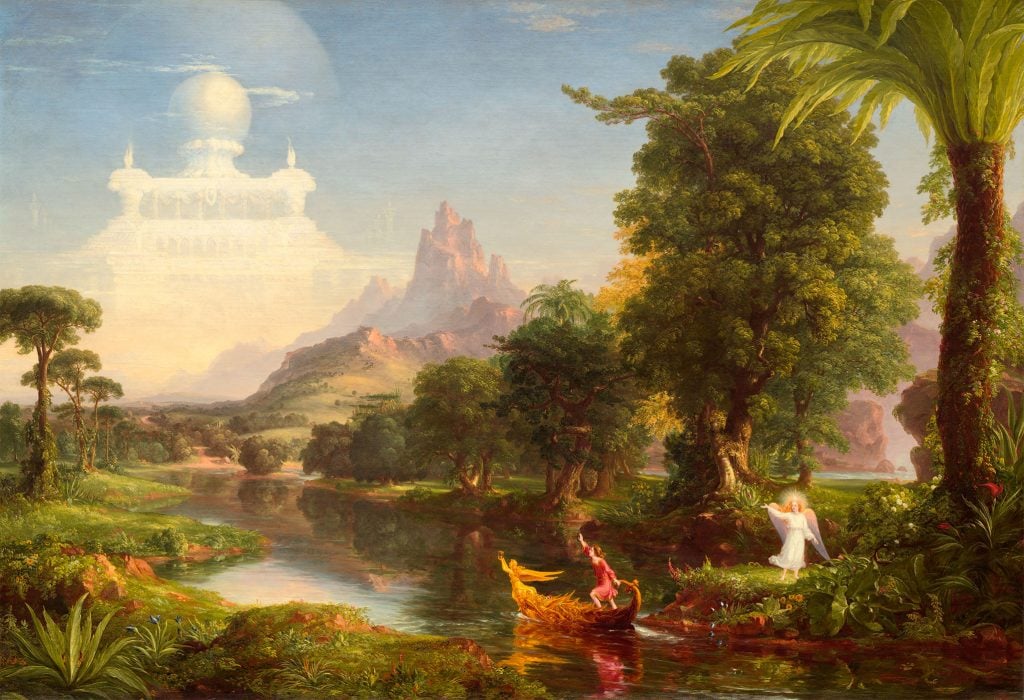
Order Print
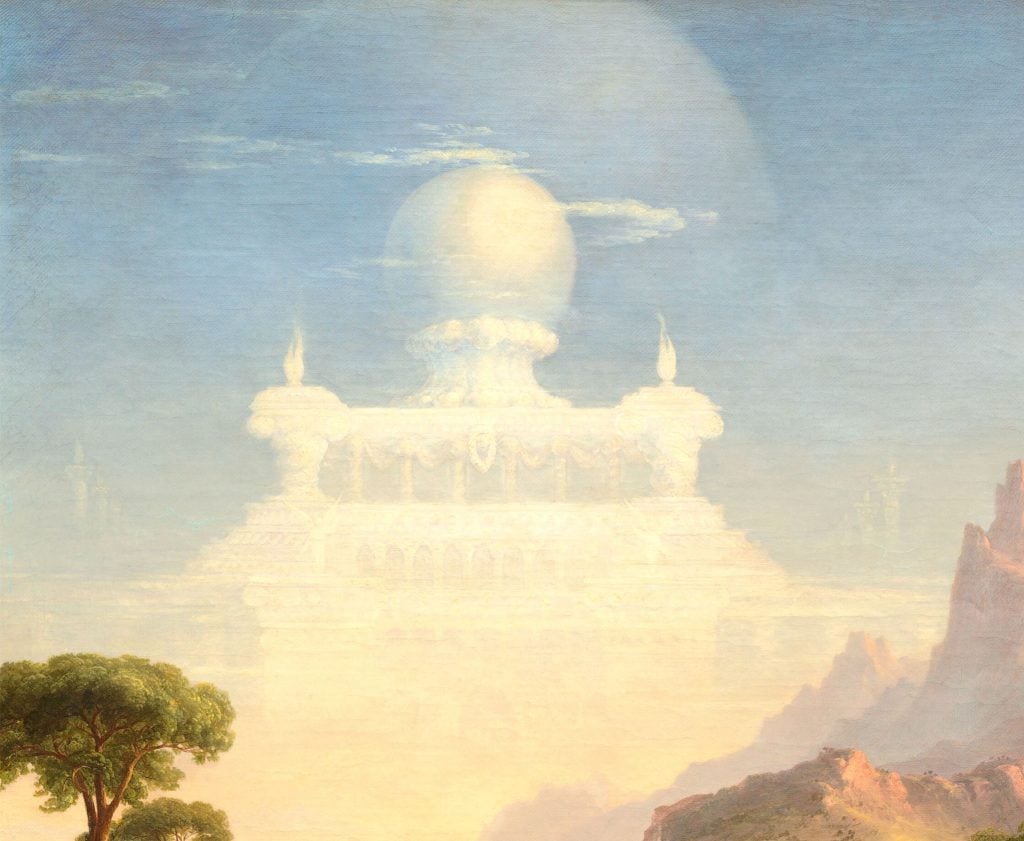
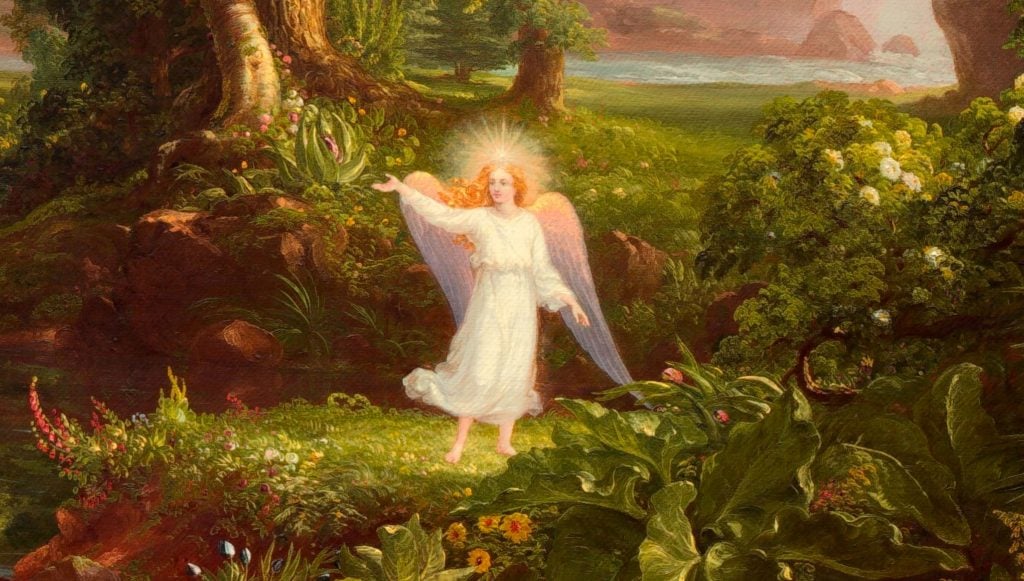
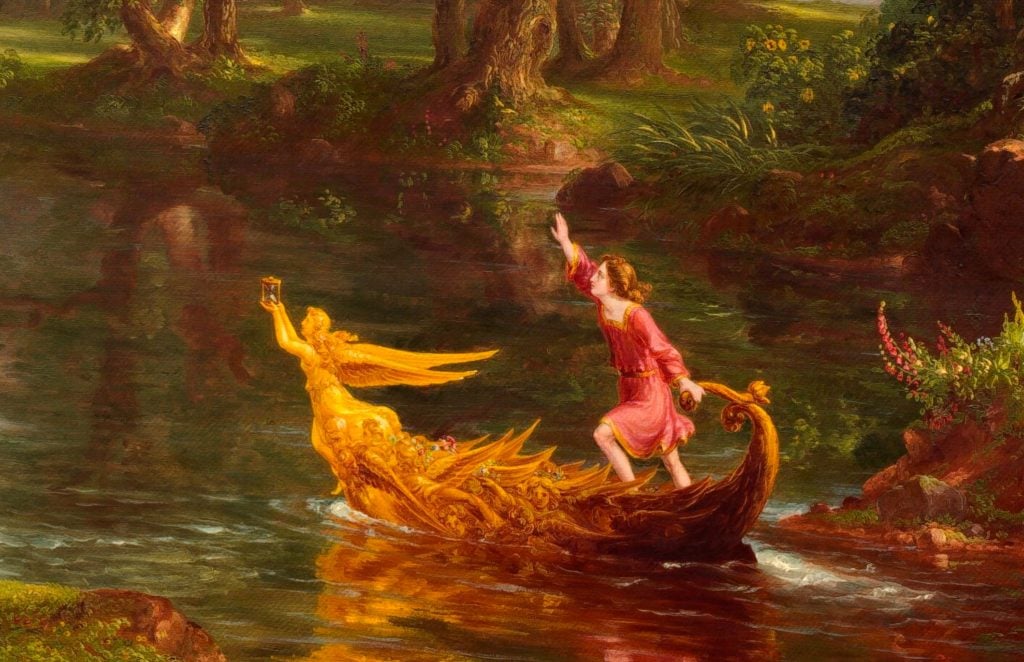
Youth has the strongest narrative of the four paintings. All appears well as the voyager reaches for his castle in the clouds, but careful examination reveals something amiss. The figures of the hours grow anxious. One meets our gaze, gesturing for us to follow the course of the river. Cole writes:
“The stream now pursues its course through a landscape of wider scope and more diversified beauty. Trees of rich growth overshadow its banks, and verdant hills form the base of lofty mountains. The Infant of the former scene is become a Youth, on the verge of Manhood. He is now alone in the Boat, and takes the helm himself; and in an attitude of confidence and eager expectation, gazes on a cloudy pile of Architecture, an air-built Castle that rises dome above dome in the far-off blue sky. The Guardian Spirit stands upon the bank of the stream, and with serious yet benignant countenance seems to be bidding the impetuous voyager ‘God Speed.’ The beautiful stream flows directly toward the aerial palace, for a distance; but at length makes a sudden turn, and is seen in glimpses beneath the trees, until it at last descends with rapid current into a rocky ravine, where the voyager will be found in the next picture. Over the remote hills, which seems to intercept the stream and turn it from its hitherto direct course, a path is dimly seen, tending directly toward that cloudy Fabric, which is the object and desire of the voyager. “The scenery of this picture — its clear stream, its lofty trees, its towering mountains, its unbounded distance, and transparent atmosphere — figure forth the romantic beauty of youthful imaginings, when the mind magnifies the Mean and Common into the Magnificent, before experience teaches what is the Real. The gorgeous cloud-built palace, whose most glorious domes seem yet but half revealed to the eye, growing more and more lofty as we gaze, is emblematic of the day-dreams of youth, its aspirations after glory and fame; and the dimly-seen path would intimate that Youth, in his impetuous career, is forgetful that he is embarked on the Stream of Life, and that its current sweeps along with resistless force, and increases in swiftness as it descends toward the great Ocean of Eternity.”
III – Manhood
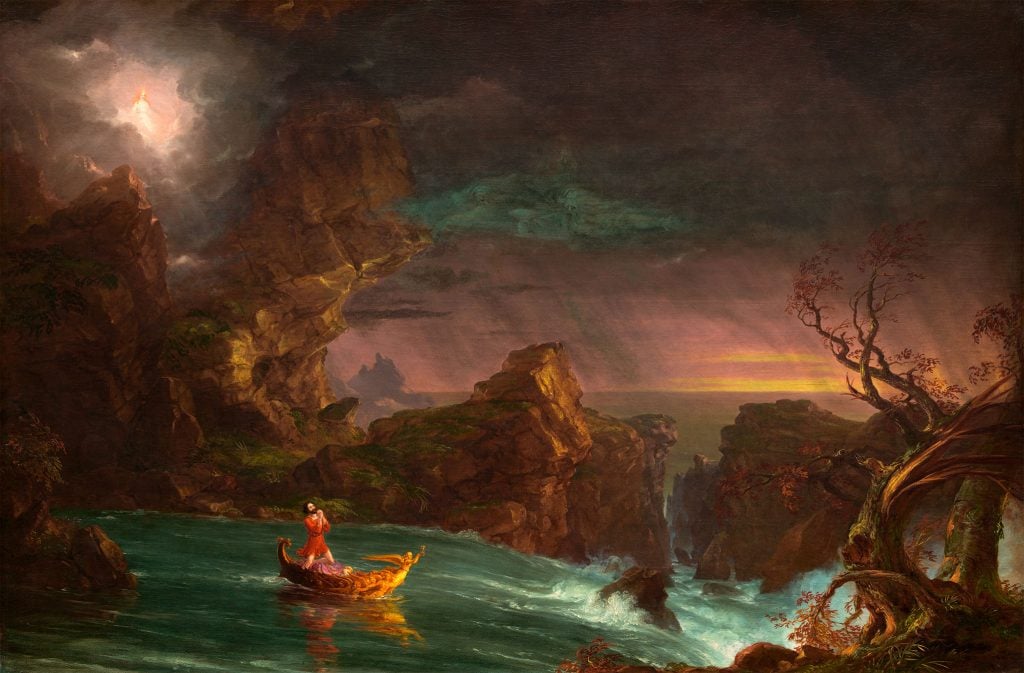
Order Print
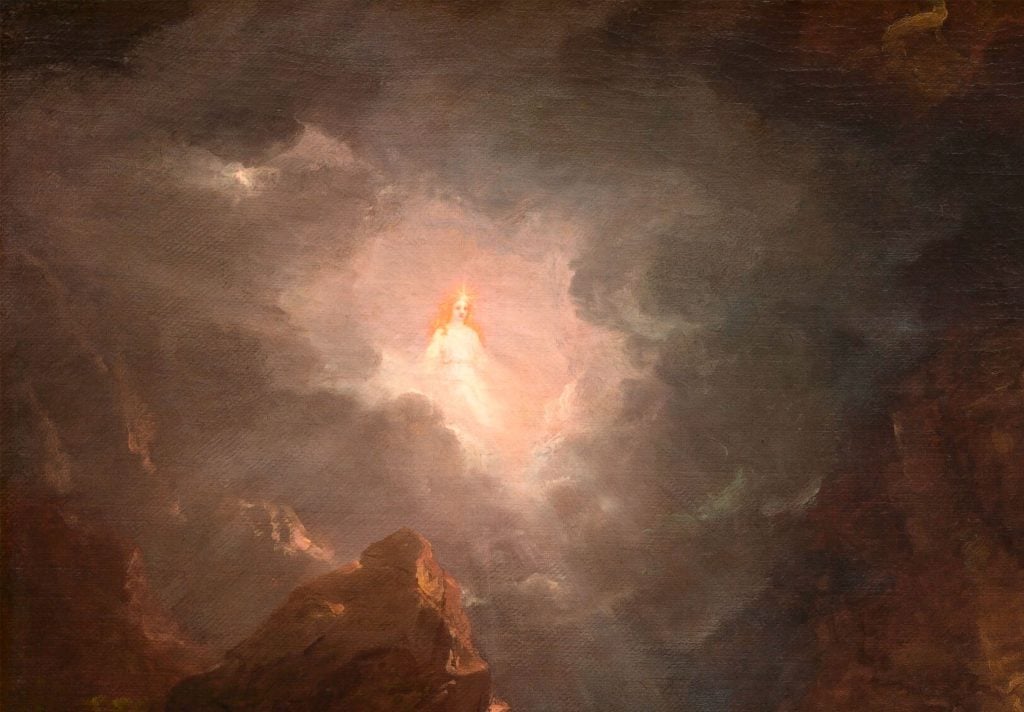

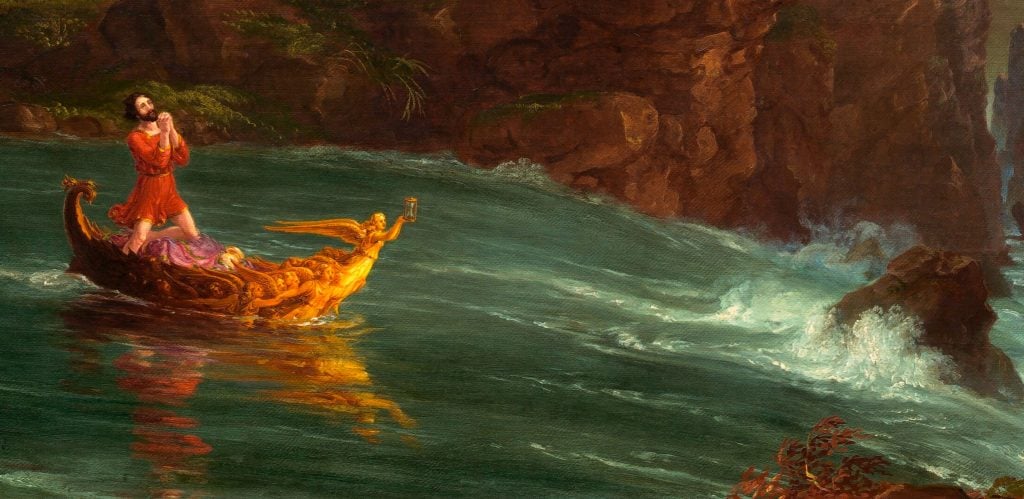
The subject of Manhood is faith. Once so eager to chart his own course, the voyager now finds himself menaced by demonic forms as he plunges toward the cataract, unable to steer his vessel or locate the guardian spirit. Faced with an impossible situation borne of his own folly, he at last cedes his destiny to a higher power. Cole writes:
“Storm and cloud enshroud a rugged and dreary landscape. Bare impending precipices rise in the lurid light. The swollen stream rushes furiously down a dark ravine, whirling and foaming in its wild career, and speeding toward the Ocean, which is dimly seen through the mist and falling rain. The boat is there, plunging amid the turbulent waters. The voyager is now a man of middle age: the helm of the boat is gone, and he looks imploringly toward heaven, as if heaven’s aid alone could save him from the perils that surround him. The Guardian Spirit calmly sits in the clouds, watching with an air of solicitude the affrighted voyager. Demon forms are hovering in the air.“Trouble is characteristic of the period of Manhood. In Childhood there is no cankering care; in Youth no despairing thought. It is only when experience has taught us the realities of the world, that we lift from our eyes the golden veil of early life; that we feel deep and abiding sorrow; and in the picture, the gloomy, eclipse-like tone, the conflicting elements, the trees riven by tempest, are the allegory; and the Ocean, dimly seen, figures the end of life, to which the voyager is now approaching. The demon forms are Suicide, Intemperance, and Murder, which are the temptations that beset men in their direst trouble. The upward and imploring look of the voyager, shows his dependence on a Superior Power, and that faith saves him from the destruction that seems inevitable.”
IV – Old Age
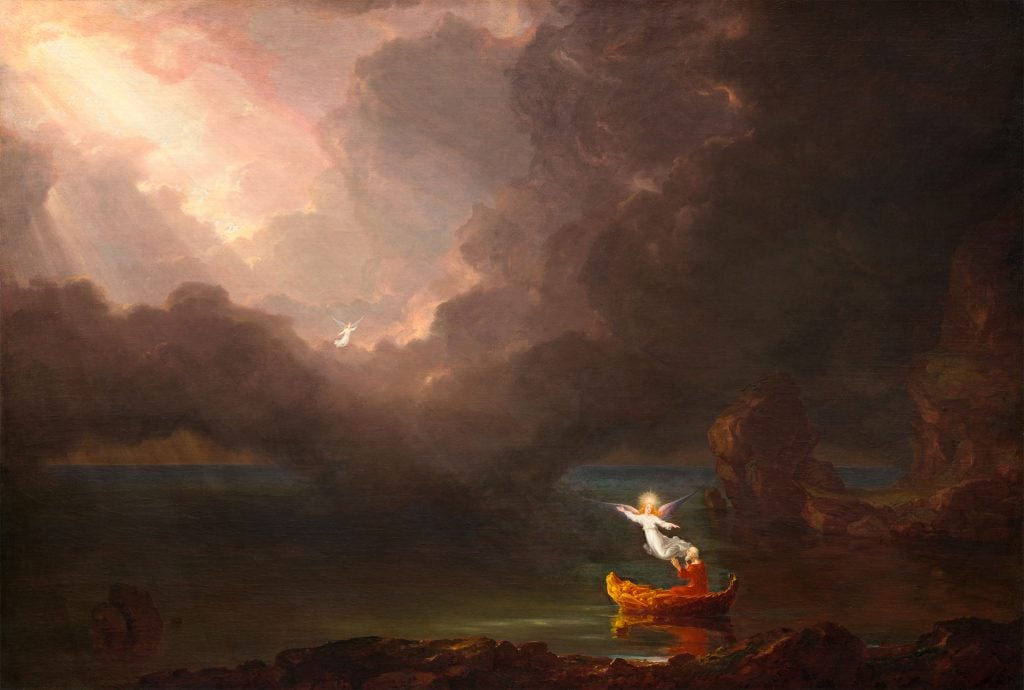
Order Print
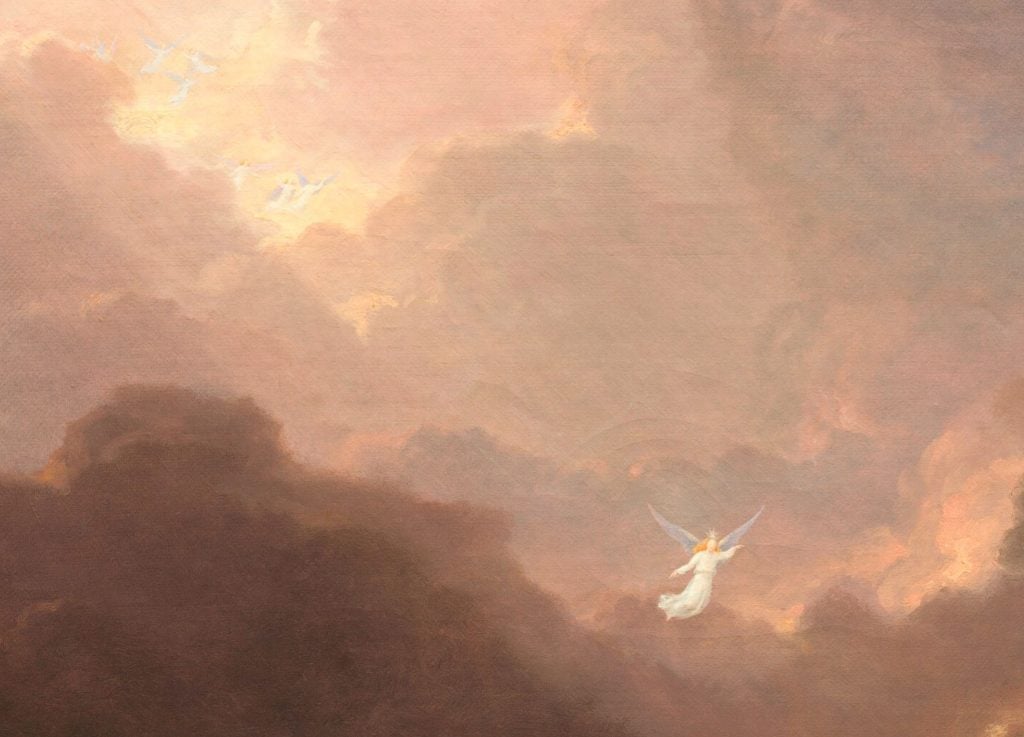
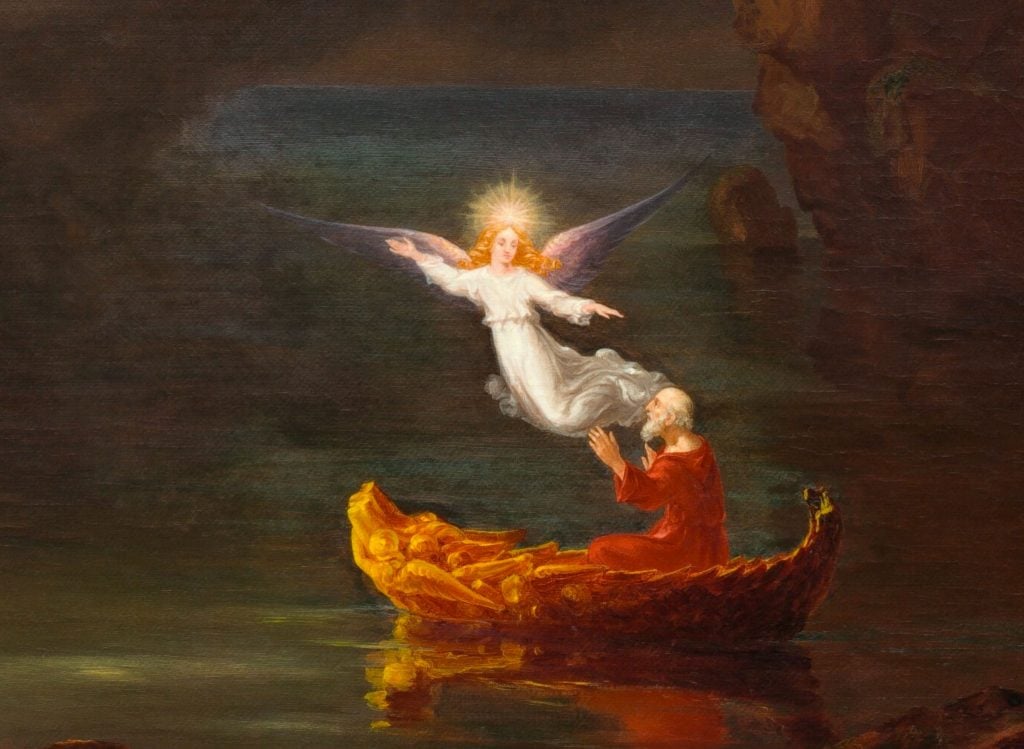
Old Age reveals deeper levels of meaning that only become apparent once the series (like life itself) has been experienced as a whole. Cole concludes:
“Portentous clouds are brooding over a vast and midnight Ocean. A few barren rocks are seen through the gloom — the last shores of the world. These form the mouth of the river, and the boat, shattered by storms, its figures of the hours broken and drooping, is seen gliding over deep waters. Directed by the Guardian Spirit, who thus far has accompanied him unseen, the voyager, now an old man, looks upward to an opening in the clouds, from whence a glorious light bursts forth, and angels are seen descending the cloudy steps, as if to welcome him to the Haven of Immortal Life.“The stream has now reached the Ocean, to which all life is tending. The world, to Old Age, is destitute of interest. There is no longer any green thing upon it. The broken and drooping figures of the boat show that Time is nearly ended. The chains of corporeal existence are falling away; and already the mind has glimpses of Immortal Life. The angelic Being, of whose presence until now the voyager has been unconscious, is revealed to him, and with a countenance beaming with joy, shows to his wondering gaze scenes such as the eye of mortal man has never yet seen.”
The Voyage of Life is, in fact, two pairs of complementary paintings, one bright and one dark, that were ideally displayed on opposite walls. The direction of the river and position of the voyager in each corresponds that of its opposite. The “close banks” and “limited scope” that protected the voyager’s innocence in Childhood become “impending precipices” that enclose him in Manhood. Having reached for the castle in the clouds in Youth, he extends a hand to the angels in Old Age. No longer chasing a mirage, he now perceives a deeper spiritual reality.
The voyager has never been in control of his own destiny. He has been fascinated by the flourishing of Childhood, the ambitions of Youth and the dangers of Manhood, but has been powerless to steer toward his desires or away from his fears. His efforts to do so only served to distance him from the guardian spirit. As he turned away from the light and became lost in himself, his inner landscape grew dark and terrifying until he he could no longer maintain the illusion that he existed separately from God. The series thus culminates in the moment when the voyager and the guardian spirit finally see face to face; a probable allusion to 13 Corinthians 11-12: “When I was a child, I talked like a child, I thought like a child, I reasoned like a child. When I became a man, I put the ways of childhood behind me. For now we see only a reflection as in a mirror; then we shall see face to face. Now I know in part; then I shall know fully, even as I am fully known.”
Conclusion
While The Voyage of Life continues to be embraced by traditionalists, the progressive art world quickly moved on. One of the first critiques to emerge was that The Voyage of Life merely articulated of Cole’s own philosophy of life, and that, as a writer for the Crayon expressed it, “There is not…in the whole series, one earnest, faithful study from nature, one object in which we can find that Cole was reverent toward those truths which it is made the duty of the landscape painter to tell us.” Successive generations of landscape painters would look directly to nature as a source of truth. Van Gogh’s Starry Night (1889), for instance, expresses the artist’s deep spiritual feeling more purely and directly than Cole’s complex narrative. Yet, it is due to artists like Cole that the art establishment would come to recognize landscape as an expressive genre that could address the fundamental mysteries of life.
—
Primary Sources
Schweitzer, Paul D. Thomas Cole’s Voyage of Life. Munson-Williams-Proctor Art Institute, 2014.
Kelly, Franklin, et al. American Paintings of the Nineteenth Century, Part I. National Gallery of Art, Washington, 1996.
